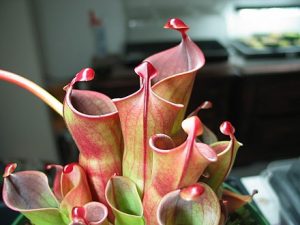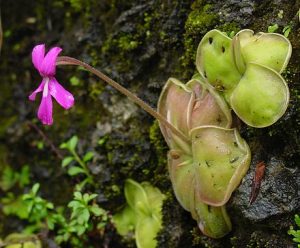5 Easy Peasy Predator Herbies
If on one hand, we have people that now more than ever are adopting the vegetarian diet over a meat-based one, on the other there are these peculiar predator plants which simply are not capable of resisting taking a bite off any careless fly, ant and every other bug (and not only), as long as it’s tiny enough to crawl over our plants’ ready traps.
You probably have had some curiosity about carnivorous plants and almost certainly as well you have imagined them to be a little too demanding for a gardener who doesn’t yet feel confident enough to handle to big a task.
Yet, the truth couldn’t be farther from what their beautiful, colourful and even eerie looking forms suggest. So yes, no need to doubt your own fastly greening thumb nor these plants’ potential as new additions to your homey garden.
I’ll now introduce you to the 5 easiest predator herbies. Every single one that you should be growing right now if you’re bored with the fact that none of your many flowerpots contains a specimen that’s at least a bit dangerous – not even a bit!
Venus Flytrap (Dionaea muscipula)
Let’s start with the most known of the whole pack, the Flytrap. And I know not whether its first name is just random or if it pays tribute to the beautiful Roman goddess. Anyway, the name is catchy and, if nothing, it helped this species skyrocket into the ears of most gardening enthusiasts.
And indeed, this tiny plant surely isn’t the ugly duckling of this list, for its jaw-like leaves with multiple thin teeth were built to trap every sorrow bug that happens to have its belly tickled by the micro-hairs implanted on the inner side of Venus’ many mouths.
After some days, the plant will have digested the prey, leaving only contours of the hardest pieces of chitin as the trap unfolds once again to the original position, eager for the next tipsy visitor.
North American Pitcher plants (Sarracenia spp.)
This type of pitcher plants is also called “hardy” because it endures well the colder Winters, at least much better than many others varieties that belong to tropical-native families. Also for the reason that it stands taller than the rest, owing to its very erect evolved leaves that work as an extended neck, ready to swallow passing insects.
You’ve probably heard that this plant, when in the wild and fully grown, has the potential to victimise even larger beings, like tadpoles and birds, which is quite impressive.
I confess that this fellow was my first carnivorous plant ever – specifically the ordinary Sarracenia purpurea – and the experience was only not the most positive because I was a true beginner and the pitcher was no more than a frail baby.
With this, I mean that besides the Venus Flytrap above, this one’s presence on your balcony of ornamentals is more than obligatory (as long as the place isn’t windy or the plant will soon be throwing up its insides!).
Butterwort (Pinguicula spp.)
Butterworts surely do not lack regarding their appearance, for they have beautiful, almost Crassulaceae-like meaty leaves while also having a unique flower that emerges right from the centre of the rosette. Plus, this bloom has a very vivid colour that no one will ignore – from blue to yellow or violet, are choices galore!
These specimens are possibly the least difficult carnivorous genus to keep, with roots that barely penetrate the soil and nutritional needs that are mostly independent of the medium where the plant is planted on.
But why this toughness (as happens with most carnivorous plants)? Well, simply because this plant depends instead on the little insects that get glued and shortly digest by its deathly glandular leaves. Those are way more nutritious than dirt could ever be.
Tropical Pitcher plants (Nepenthes spp.)
The Nepenthes are most definitely on the top three of coolest and most effective killers in the Plantae kingdom. Tropical by nature, they will love you for your bright and moist, lukewarm porch, if you have it, but if you do not, they’re still resilient enough to adapt and keep (literally) hanging around.
Suspended pots are the predilect spot for these pitchers and you need only keep watering them – and don’t get disoriented and pour water into their deep cups like you’d do with Bromeliads – making sure that there’re no slugs and such plagues munching on its light-green leaves.
Seeing that these carnivorous are a bit more of an investment than many other kinds, make sure you have all the conditions necessary to shelter these voluminous plants beforehand. As I said, some are hardier than others and so, having a good eye for the right pick is important, even though the varieties of garden plants usually found at the supermarkets will more often than not be the easiest to tend to, which makes our lives automatically simpler.
Sundews (spp.)
I’ll complete this list with a very elegant genus. Having ropy leaves layered with very fine hairs on whose tip accumulate droplets of what looks like dew (hence their name) but is in truth a powerful enzymatic cocktail that starts digesting the insects’ body as soon as they land on them.
One other funny aspect is this plant’s ability to curl its leaves around the newly trapped bug so that it does not get away until it’s too late.
Being also quite cheap and very easy to maintain next to any sunny window, the species within this genus are each an interesting choice for beginner gardeners.
And since it’s the strangest of all the carnivorous plants here, especially because of the body texture and method behind the killing, sundews win the spot as creepiest plants that many of us could have gifted our dearest tricksters this bygone Halloween.
As you can see, the choice isn’t immense but still, this handful is more than enough for you to start off knowing the very interesting realm of predatory plants. Then, once you grow accustomed to the type of care these specimens demand, you’ll easily get more and more interested in this big group of leafy assassins.
So much that, in time, you shall come across many other options that you can fit into your indoor garden, revesting it with such a wide array of bad fellas that your guests might even feel wary about sharing the room with them.
Ricardo Elisiário is a frenetic freelance writer for hire. He should probably act more like the agricultural engineer he is, yet you’ll find him creating copy and content for websites, print… and his own amusement, as he’s up to becoming the new Dickens someday. To find out more about this Lisbon-born wifey-lover, visit his website or say hello @wRicardowrites.





